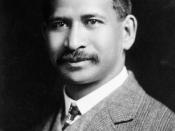Few figures cast as long a shadow over New Zealand history as Sir Apirana Ngata. He is not only the first Maori university graduate, but also the country's first BA/LLB recipient and was a member of parliament for thirty-eight years whose initiative and determination aided the survival of Maori culture. This essay will explore three of his accomplishments, particularly in Maori arts: the popularisation of Maori oratory arts, the revival of traditional Maori architecture and the establishment of the School of Maori Arts and Crafts.
Early in his career, Ngata recognised the need to perpetuate a Maori renaissance in order to create a national Maori identity in reaction to the government's assimilationist policies . He began striving for this through the popularisation of the oratory arts. Ngata observed the popularity of Pakeha song and utilised this to appeal to Maori youths . With the aid of Northern Maori MP, Hone Heke, Ngata translated Pakeha songs into Maori as well as applying original Maori lyrics to Pakeha tunes .
During the First World War, Ngata became aware of both a need to create a forum for Maori competition and a way to raise funds for the war effort . Combining these goals Ngata set up a number of concert parties and building openings that held inter-tribal demonstrations of whaikorero, kapa haka, waiata and poi . In the early stages the performers were chiefly from Turanga, Ngati Kahungunu, and Ngati Porou, however, with Ngata's assistance, knowledge of such arts was imparted to others who had lost it .
Along with renewing interest in Maori oratory arts, Ngata made recordings of traditional waiata and whaikorero around 1919 . He utilised the latest technology such as dictaphone cylinders and aluminium discs for reference in case the art should be lost .


